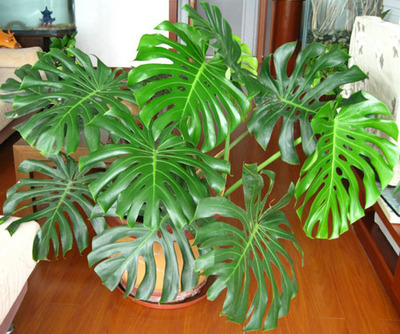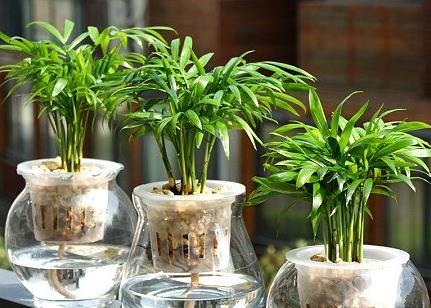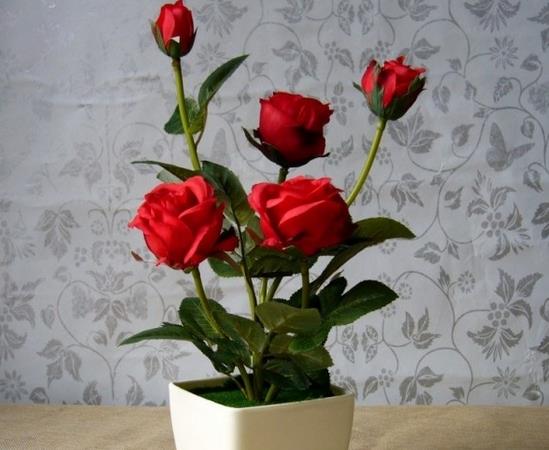What are the breeding methods and matters needing attention of tortoise back bamboo?
We can always see all kinds of potted plants in the homes of florists, and tortoise-backed bamboo is one of them. Tortoise back bamboo leaves are strange, very much like turtle back, it is a famous foliage plant, suitable for potted plants, is widely cultivated in indoor decoration, ornamental. So what do you know about the breeding methods and points for attention of tortoise-backed bamboo? The editor will answer for you.
What are the breeding methods and matters needing attention of tortoise back bamboo?
1. Lighting: tortoise back bamboo sex like a warm and humid environment, avoid drought, afraid of direct sunlight, otherwise it is easy to cause withered leaves. In summer, the tortoise-backed bamboo should be placed indoors or under the shade shed, not on the balcony where the sun is too strong, so it is easy to die. When the temperature drops to 6 ℃ in winter, the tortoise-backed bamboo should be moved indoors to keep warm.
two。 Watering: the water of the tortoise back bamboo should be sufficient, and the culture soil must be kept moist often. during the summer growth period, it should be watered once in the morning and in the evening, and the leaf surface should be often watered to keep the leaves bright and the air moist. If the water evaporates slowly in winter, the water will be irrigated once every 4 days. It can be watered once a day.

What are the breeding methods and matters needing attention of tortoise back bamboo?
3. Fertilization: tortoise back bamboo is a more fertilizer-loving plant, so we should pay attention to fertilizing it properly. During the growth period of the tortoise back bamboo, thin pancake fertilizer and water should be applied every half a month. If the fertilizer is adequate and appropriate, the tortoise back bamboo will grow with lovely leaves.
4. Diseases and insect pests: tortoise-backed bamboo is very vulnerable to shell insects, and its stems and leaves are most vulnerable to shell insects. It can be sprayed with 1000 times omethoate after cleaning with an old toothbrush. The common diseases of tortoise back bamboo are leaf spot, gray spot and stem blight, so we should pay attention to timely control.
5. Change the basin: the turtle back bamboo pot needs to be changed once a year, and the best time to change the basin is between March and April. When changing the basin, remove the old soil, cut off the withered roots of the tortoise back bamboo, and then add mature organic fertilizer or phosphorus and potash fertilizer as base fertilizer.
Culture methods and precautions of tortoise back bamboo when I first saw it, the editor thought it was a kind of tortoise. (scientific name: Monstera deliciosa). Also known as "Penglai banana", "Euphorbia", evergreen vine. The stem is stout; the young leaves are heart-shaped without holes, and when they grow up, they are widely ovate and pinnately parted; there are oval perforations between the veins of the leaves, and the leaves are long-stalked and dark green. Buddha flame inflorescence, Buddha flame boat-shaped, November flowering, yellowish. There are brown air roots on the stem, shaped like electric wires, hence the name "electric grass"; the leaves are oval, in the shape of tortoise shell-shaped veins scattered with many oblong holes and deep cracks, its shape is like a tortoise shell pattern, and the stem has nodes like bamboo stems, hence the name "tortoise back bamboo". Fleshy inflorescence, the whole flower is shaped like a "table lamp", with a lampshade and a light bulb. Below, the editor of the network will introduce to you the breeding methods and matters needing attention of the tortoise back bamboo.
Culture methods and matters needing attention of tortoise-backed bamboo
Culture methods and matters needing attention of tortoise back bamboo soil requirements
Because the tortoise back bamboo grows rapidly during the growth period, it is necessary to leave a relatively spacious cultivation space to avoid affecting the extension of its stems and leaves. Pot cultivation of tortoise back bamboo needs to use slightly acidic soil with loose fertility, large water absorption and good water retention. For example, rotten leaf soil or peat soil.
The culture method of tortoise back bamboo and the moisture of matters needing attention
Tortoise back bamboo likes to be wet, so it is appropriate to keep the basin soil dry and uncracked, moist but not wet. And the air humidity of the environment had better be kept at about 60%. It is necessary to spray and water the leaves every day in summer to keep them bright. But there is no need to spray water on the leaves in winter, otherwise the leaves may appear black spots, or even black and rotten.
Culture methods and matters needing attention of tortoise back bamboo
Tortoise back bamboo shade, avoid direct sunlight, as an indoor pot placed in the light is the most suitable. Tortoise back bamboo likes to be warm and humid and can grow well at normal room temperature. It is not cold-resistant and the overwintering temperature is required to be above 5 ℃.
Culture methods of tortoise back bamboo and fertilization of points for attention
During the period from April to September, the tortoise back bamboo is in a period of vigorous growth, during which thin liquid fertilizer needs to be applied every half a month. During the two-week growth period, 37% or 28% of nitrogen liquid fertilizer is irrigated once in two weeks to make the plant strong. It is necessary to apply more phosphorus and potassium fertilizer after autumn to make the stem more sturdy and prevent lodging.
Cultivation methods and matters needing attention of tortoise back bamboo cultivation and pot change
Tortoise back bamboo pot should set up a pillar in the basin, let it climb, every spring need to change the basin, change the basin once a year. The best time to change the basin is between March and April. Remove the old soil and cut off the dead roots when changing the basin. In the basin, mature organic fertilizer or phosphorus and potassium fertilizer are added as base fertilizer.
Culture methods and matters needing attention for pest control of tortoise back bamboo
Shell insects are the most common pest of tortoise-backed bamboo. When a small amount occurs, they can be cleaned with an old toothbrush and sprayed with 1000 times omethoate EC. The common diseases are leaf spot, gray spot and stem blight, which can be sprayed with 65% zinc wettable powder 600 times.
Culture methods and matters needing attention of tortoise back bamboo picture of tortoise back bamboo culture method of turtle back bamboo
Tortoise-backed bamboo is a kind of radiation-proof plant. With its sense of elegance, elegance and elegance, it attracts the attention of many consumers, and more and more people introduce it into the list of potted indoor ornamental plants. In this paper, combined with the pictures of tortoise back bamboo, we will talk about the culture method of tortoise back bamboo. [recommended by the editor] Indoor plants touch fragrant wood, hydroponic plants, small potted plants, flowers, fengshui, radiation-proof plants, pictures of tortoise-backed bamboos, culture methods of tortoise-backed bamboos-
[plant archives]-
English name: tortoise back bamboo
Scientific name: Monstera deliciosa
Alias: Penglai banana, iron silk orchid, perforated Xi Lin taro, tortoise back banana, clematis, dragon palm, electric orchid, tortoise back taro
Division: Tiannanxing
Genus: Phyllostachys
Distribution of origin: it is native to the tropical rain forest of Mexico and is widely introduced and cultivated in China.
Morphological features: the stem is stout, and the nodes are more like bamboo. There are long and drooping brown aerial roots on the stem, which can cling to other things and grow upward. Leaves thickly leathery, alternate, dark green or green; leaves thickly leathery, alternate, dark green or green; young leaves heart-shaped, without perforation, growing up rectangular-rounded, with irregularly pinnately parted, pore-lobed from leaf margin to leaf veins; 30ml 50 cm long, dark green, with leaf scars; bracts, leathery, yellowish white at leaf scars. The flowers are shaped like Buddha's flame and yellowish. The fruit is edible.
How to raise turtles with bamboo on their backs? -"five joys and five taboos"-raising turtles and carrying bamboo-
◆ a warm bogey cold tortoise back bamboo native to the Mexican rainforest, like the warm environment, avoid freezing cold weather. The temperature above 5 ℃ will not suffer frost damage, and the temperature above 12 ℃ will grow well.
◆ second is like shade and cool taboo strong light turtle back bamboo strong shade tolerance, in the semi-shade environment, the growth is particularly good, the performance is exuberant, the aerial root is developed, the leaf is hypertrophy, the leaf color is bright and dark green.
◆ 3 is fond of wetting, avoiding waterlogging, tortoise back bamboo likes to grow in a humid ecological environment. There are many Rain Water in the south, if the waterlogging accumulation time is too long, there will be rotten roots, rotten stems and leaves.
◆ 4 is fertile soil, bogey lean soil, turtle back bamboo likes fertile soil, especially fertile sandy loam, although it can grow on thin red and yellow soil, its growth becomes weaker, tree posture is deformed, leaves become smaller and leaf color becomes lighter, which affects the ornamental effect.
◆ 5 is like soil fertilizer avoid chemical fertilizer turtle back bamboo often apply organic fertilizer, such as cake fertilizer, man-made organic fertilizer, livestock and poultry manure, soil manure and so on, its tree is strong, the leaves are as big as plates, the leaves are thick, the leaves are dark green and glowing, especially the tortoise shell pattern is more clear.
According to the characteristics of "five joys and five taboos" of tortoise back bamboo, shade and dampness management should be carried out in summer and autumn to avoid direct sunlight, watering twice a day, leaf surface often spraying water to maintain air humidity, keeping room temperature more than 5 ℃ in winter, outdoor cultivation and film mulching to keep it safe through the winter. If properly maintained, the tortoise back bamboo, which is more than 4 years old, will also bloom, with single petals wrapped in berries, bright jade flowers, yellowish berries and long oval berries; its fleshy spikes can be used for cooking, and the berries can also be eaten when ripe.
The culture method of tortoise-backed bamboo-
① sowing
Phyllostachys pubescens blossoms in summer, in order to improve the seed setting rate, artificial pollination is needed. The second pollination is the best at 9 ~ 10:00 and 3 ~ 4 p.m., and the success rate of pollination is high. It takes 15 months from pollination to seed maturity. Attention should be paid to ventilation and fertilizer and water management at the stage of seed development to promote fruiting and fullness.
Soak the seeds in 40 ℃ warm water for 10 hours before sowing, and the sowing soil should be sterilized at high temperature. The seeds of Phyllostachys pubescens are larger and can be sowed on demand. After sowing, the seeds can be kept at room temperature for 20: 25 ℃, and the box mouth is covered with plastic film to maintain more than 80% humidity. If the room temperature is too low in the process of sowing, not only the emergence of seedlings will be affected, but even the seeds will rot like water stains.
② cuttage
Stem and node cuttings can be used in both spring and autumn, and the cuttings from April to May in spring and September to October in autumn are the best. Because during this period of time, the temperature is suitable for stem node incision healing and rooting, and the survival is quick.
Cuttings selected stem tissue full, robust growth of the current year side branches, cuttings length of 20-25 cm, cut off the leaves at the base. Retain the upper leaflet, cut off the long aerial root, retain the short aerial root, in order to absorb water, conducive to hairy roots. The mixed substrate of coarse sand and peat or rotten leaf soil was used to keep 2527 ℃ and high air humidity after insertion, and it began to take root about one month after insertion. After the cuttings took root, the axillary buds on the stem nodes also began to sprout and spread leaves. In order to accelerate seedling growth, keep more than 10 ℃ at room temperature, strengthen fertilizer and water management, and seedling shaping can be used as a commodity in the second year after planting.
Ramet: in summer and autumn, the side branch of the large tortoise back bamboo is split off, with part of the aerial root, directly planted in the barrel or bowl, not only the survival rate is high, but also the molding effect is fast.
③ cultivation
The cultivation of tortoise back bamboo is very easy, which usually uses the same amount of rotten leaf soil, garden soil and river sand as the substrate. When planting, add a small amount of bone meal and dried cow dung as base fertilizer. The moist tortoise back bamboo needs enough water to keep the basin soil moist. Of course, it is necessary to spray water to the leaves when the weather is dry, in order to keep the air moist, pay attention to shade in the growing season, avoid strong light, especially in midsummer can not be placed in the sun, otherwise it is easy to cause leaves scorched, burns, affecting the ornamental value.
Conclusion: today, the large-scale potted bamboo has become the main backbone material in the hotel lobby, and the bamboo planted in small and medium-sized pots will also be one of the ornamental plants in modern family decoration, which is very common in China. Of course, the potted turtle-backed bamboo is lovely, not because it is a famous indoor potted foliage plant, but also because it has a strange ability to absorb carbon dioxide at night.
[more Encyclopedia of plants]
The culture method of Douban green the culture method of iron tree the function of cactus the characteristics of peony flower how to raise Milan flower
The culture methods and precautions of green pineapple? does the fairy ball protect against radiation? the current culture method of cyclamen leaves yellow and blue witch price
The cultivation method of iron tree of rich bamboo and iron tree is the rubber tree poisonous? is the sun flower language safe tree cyclamen Phnom Penh tiger skin orchid
How to raise nine big flowers of Cymbidium, Cymbidium, Red Palm, Red Crane, poisonous Cymbidium, Cymbidium, C
- Prev

What are the breeding methods and points for attention of pocket coconuts?
1. Lighting: pocket coconuts prefer semi-shade, and their leaves will turn yellow in strong sunlight. If placed in places where there is not enough light for a long time, the plants will become thin and long. So it's best to put it in a bright place by the window indoors. 2. Temperature: pocket coconuts like to be warm, the suitable temperature for growth is 18 Mel 24 degrees Celsius, 13 degrees Celsius goes into dormancy.
- Next

How to grow rose bonsai? Let your potted roses smell all over the house
As a kind of plant with beautiful flowers and strong fragrance, rose has high ornamental value. At present, more and more people begin to plant roses in pots, making them the best embellishment and beautification flowers in people's home life. So, what about potted roses?
Related
- Fuxing push coffee new agricultural production and marketing class: lack of small-scale processing plants
- Jujube rice field leisure farm deep ploughing Yilan for five years to create a space for organic food and play
- Nongyu Farm-A trial of organic papaya for brave women with advanced technology
- Four points for attention in the prevention and control of diseases and insect pests of edible fungi
- How to add nutrient solution to Edible Fungi
- Is there any good way to control edible fungus mites?
- Open Inoculation Technology of Edible Fungi
- Is there any clever way to use fertilizer for edible fungus in winter?
- What agents are used to kill the pathogens of edible fungi in the mushroom shed?
- Rapid drying of Edible Fungi

